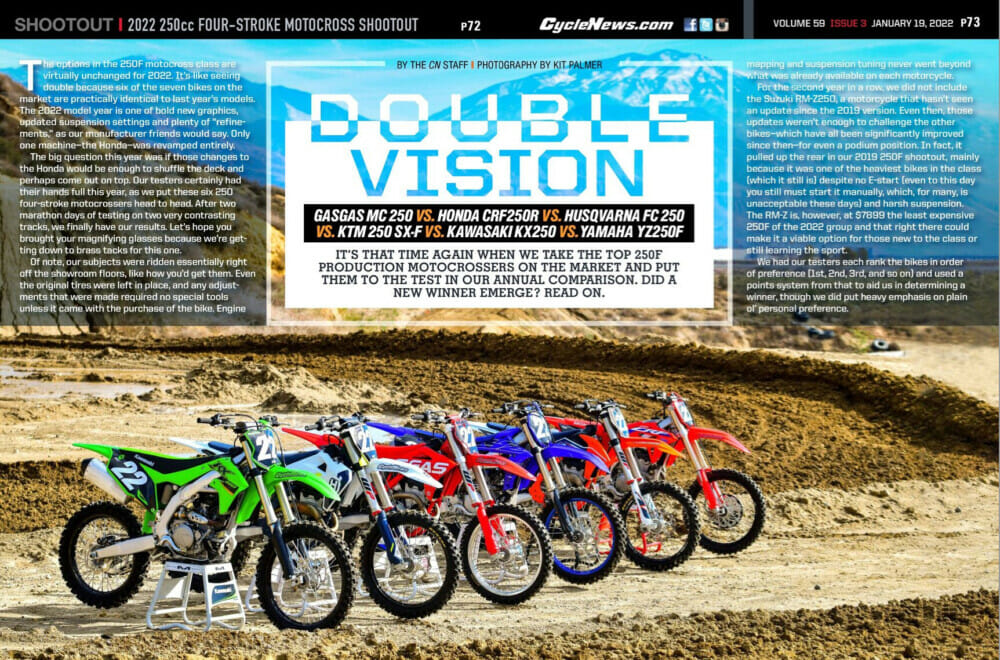Cycle News Staff | January 19, 2022
It’s that time again when we take the top 250F production motocrossers on the market and put them to the test in our annual comparison. Did a new winner emerge? Read on.
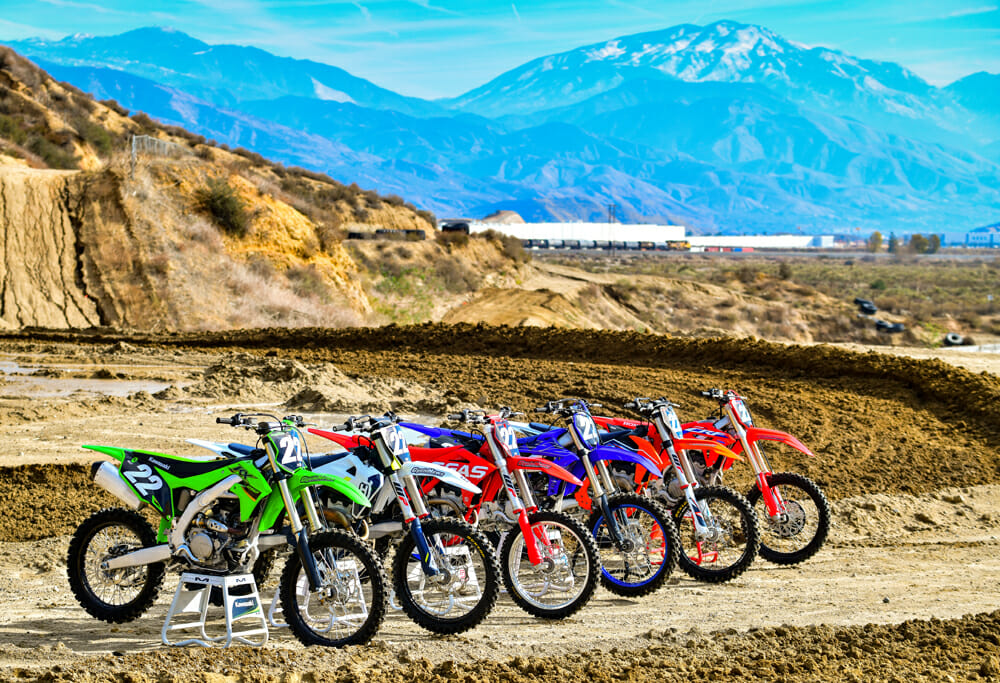
GasGas MC 250F vs. Honda CRF250R vs. Husqvarna FC 250 vs. KTM 250 SX-F vs. Kawasaki KX250 vs. Yamaha YZ250F
By the CN Staff | Photography by Kit Palmer
The options in the 250F motocross class are virtually unchanged for 2022. It’s like seeing double because six of the seven bikes on the market are practically identical to last year’s models. The 2022 model year is one of bold new graphics, updated suspension settings and plenty of “refinements,” as our manufacturer friends would say. Only one machine—the Honda—was revamped entirely.
The big question this year was if those changes to the Honda would be enough to shuffle the deck and perhaps come out on top. Our testers certainly had their hands full this year, as we put these six 250 four-stroke motocrossers head to head. After two marathon days of testing on two very contrasting tracks, we finally have our results. Let’s hope you brought your magnifying glasses because we’re getting down to the brass tacks for this one.
Of note, our subjects were ridden essentially right off the showroom floors, like how you’d get them. Even the original tires were left in place, and any adjustments that were made required no special tools unless it came with the purchase of the bike. Engine mapping and suspension tuning never went beyond what was already available on each motorcycle.
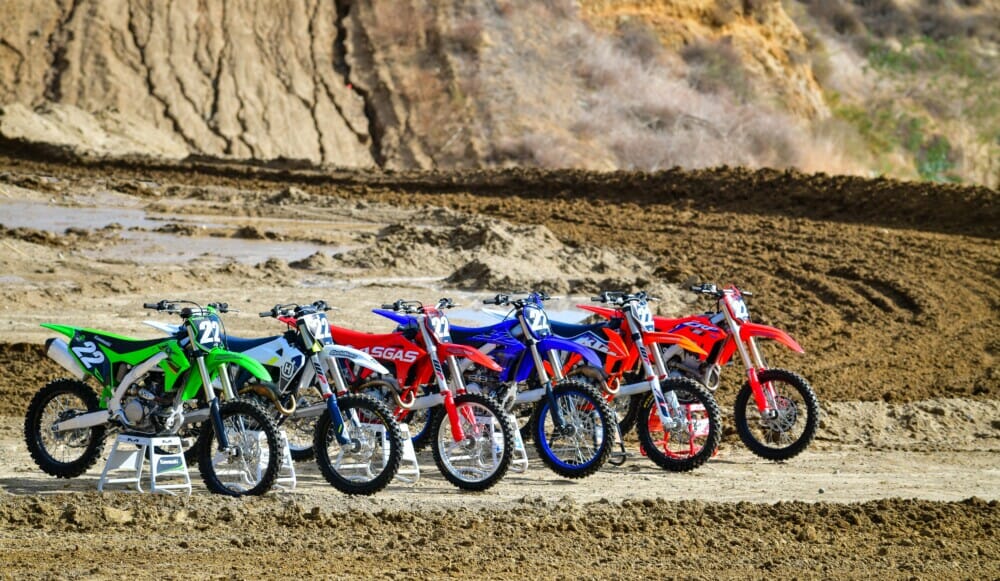
For the second year in a row, we did not include the Suzuki RM-Z250, a motorcycle that hasn’t seen an update since the 2019 version. Even then, those updates weren’t enough to challenge the other bikes—which have all been significantly improved since then—for even a podium position. In fact, it pulled up the rear in our 2019 250F shootout, mainly because it was one of the heaviest bikes in the class (which it still is) despite no E-start (even to this day you still must start it manually, which, for many, is unacceptable these days) and harsh suspension. The RM-Z is, however, at $7899 the least expensive 250F of the 2022 group and that right there could make it a viable option for those new to the class or still learning the sport.
We had our testers each rank the bikes in order of preference (1st, 2nd, 3rd, and so on) and used a points system from that to aid us in determining a winner, though we did put heavy emphasis on plain ol’ personal preference.
In This Corner…
2022 Yamaha YZ250F
MSRP: $8499
Wet Weight: 235 lbs.
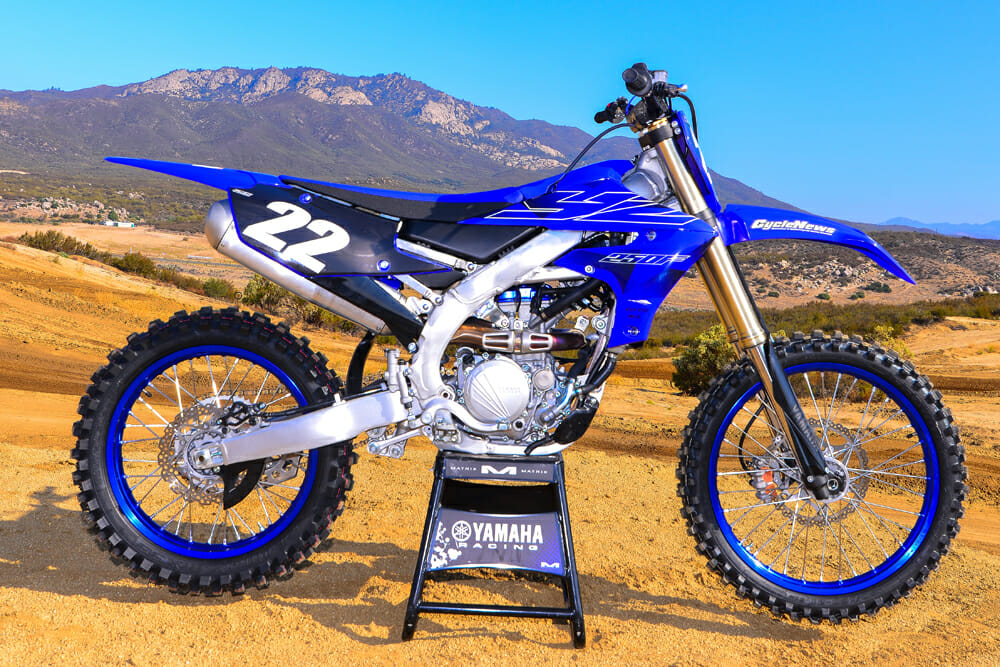
If it ain’t broke, don’t fix it. That seems to be the motto with the current 250 offering from Yamaha. The YZ250F is deep in its model cycle. The current generation YZ250F debuted in 2019, and it is by far the most dominant 250F on the pro-racing scene as of late. Minor changes are seen on the ’22 version, including a new rear-wheel setup—a wider 2.15-inch-wide rear wheel with a three-cross-spoke pattern and a 110-width Dunlop MX33 rear tire to match. As usual, updated suspension settings and graphics have been added, too. The blue crew has placed first in our shootouts for two years running and looks for an elusive three-peat in 2022.
2022 Husqvarna FC 250
MSRP: $9499
Wet Weight: 234 lbs.
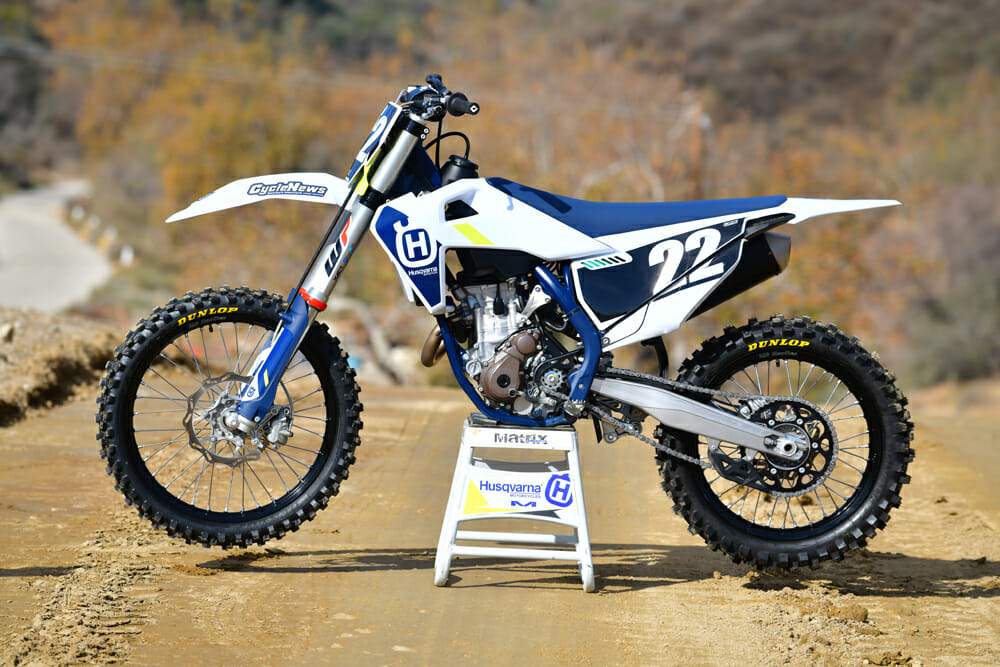
The Husqvarna FC 250 is one of the three Austrian-built/KTM-owned motorcycles in this comparison. It’s the most premium option of the three and of the entire 250F market, for that matter. Before you call it a “white KTM,” think of it like General Motors. GM sells Cadillac, GMC, and Chevy. All are virtually the same brands but with different trims. You could look at it as Husqvarna being the Cadillac, KTM the GMC and GasGas the Chevy. The Husky is the most expensive 250F in the field at $9499 and comes with features that match its price tag. A steel frame, carbon-composite subframe, Brembo brakes, and the two-map traction control switch all come standard. For ’22, the Husky gets new graphics and a new Brembo (formerly a Magura) hydraulic-clutch assembly.
2022 KTM 250 SX-F
MSRP: $9399
Wet Weight: 232 lbs.
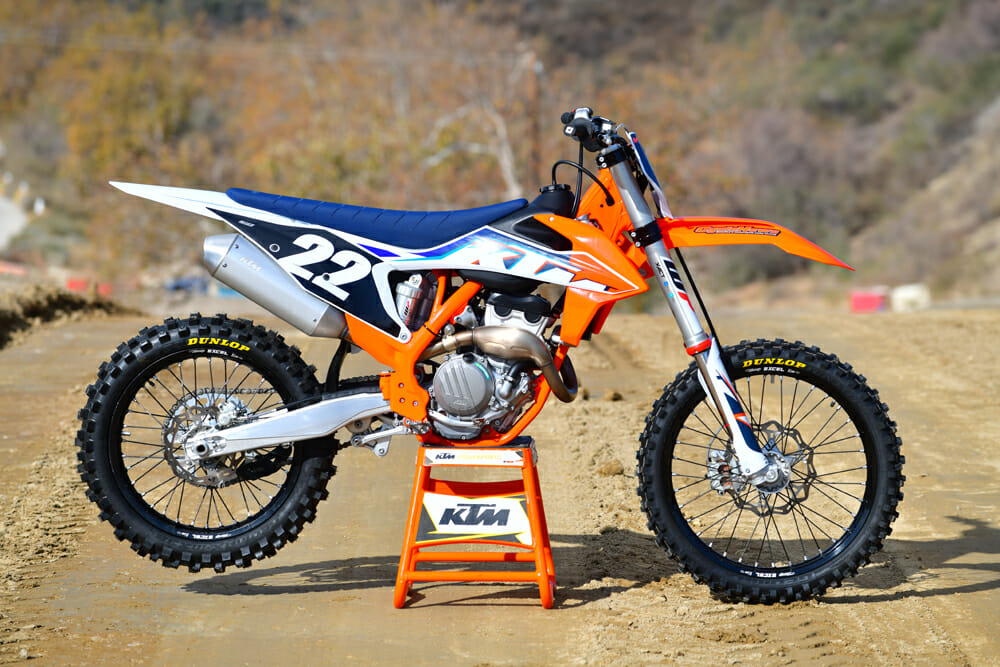
For ’22, the KTM 250 SX-F sees no significant changes from 2021. It continues to ride on a steel frame and WP suspension—air fork up front and spring shock in the rear. Selectable mapping, traction control, Brembo brakes and a Brembo hydraulic clutch system add to the list of premium components once again found on the KTM. It matches the lightest bike in the class (tied with the GasGas and Honda at 232 pounds) but is the second heaviest on the wallet ($9399 and just $100 less than the Husqvarna). The Orange Brigade hopes the “you get what you pay for” shtick gets them to the top step this year.
2022 GasGas MC 250F
MSRP: $8699
Wet Weight: 232 lbs.
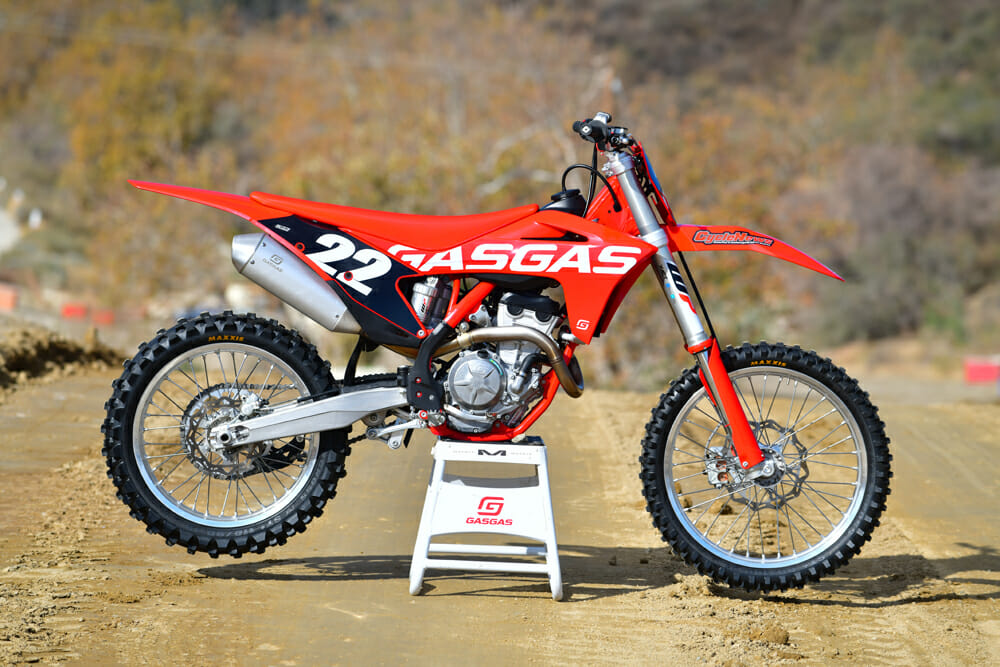
This is the second time GasGas has entered the shootout season, and the MC 250F remains unchanged for this model year. The “Chevy” of the Austrian bikes is considered more of the “base model” but still comes standard with the same frame, motor, suspension, clutch and brakes found on the KTM and the Husky. Significant differences for this red ride are the aluminum subframe, forged triple clamps, aluminum handlebars, and silver wheels. The MC 250F does not have a map switch or traction control (a factory option for about $150). The catch here is the GasGas is a full $700 cheaper than its KTM brethren and $800 less than the Husqvarna.
2022 Kawasaki KX250
MSRP: $8399
Wet Weight: 237 lbs.
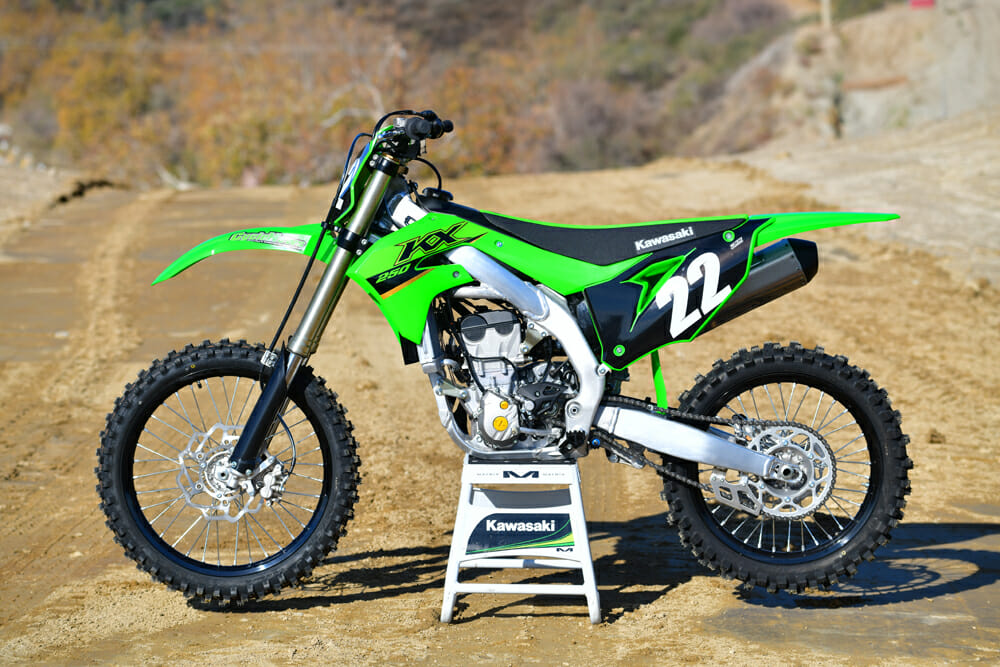
The KX250 was completely redesigned in 2021 and returns similarly for the ’22 model year with a set of “bold new graphics.” Last year the bike received refreshing updates that included a new frame, swingarm, motor package, hydraulic clutch and an electric starter. Many of these changes emulated the popular KX450 but added four pounds to the 250’s overall weight. At 237 pounds fully fueled, it is the heaviest 250F in the class. Last year our team praised the Kawi, but it ultimately fell just one spot short of the shootout podium.
2022 Honda CRF250R
MSRP: $8099
Wet Weight: 232 lbs.
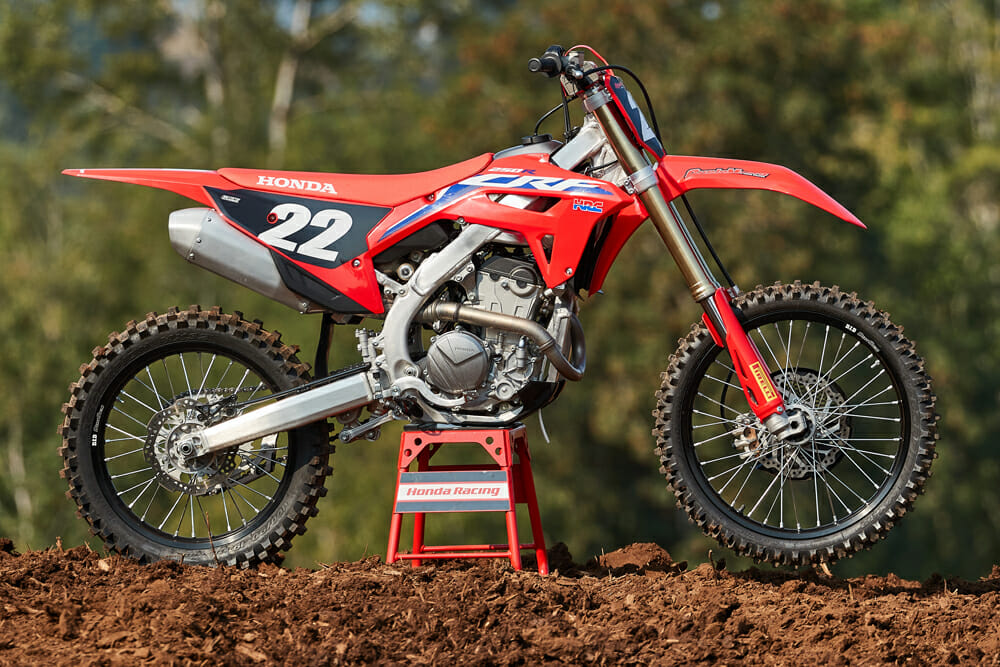
Honda’s CRF250R is the only bike in the class to get a complete redesign in 2022. And thankfully so because it needed it most. The red ride shed five pounds from last year and follows suit of its 450 big brother, receiving extensive updates to the engine as well as a new frame, swingarm and bodywork. Gone are the dual exhausts, and a simpler single-sided system is found on this year’s CRF. It rides on Showa suspension components, and Pirelli Scorpion tires mounted front and rear. A few pieces trickle over from the ’21, including the cable-operated clutch and a three-mode map switch. The big question will be if these changes are enough to take home the top spot.
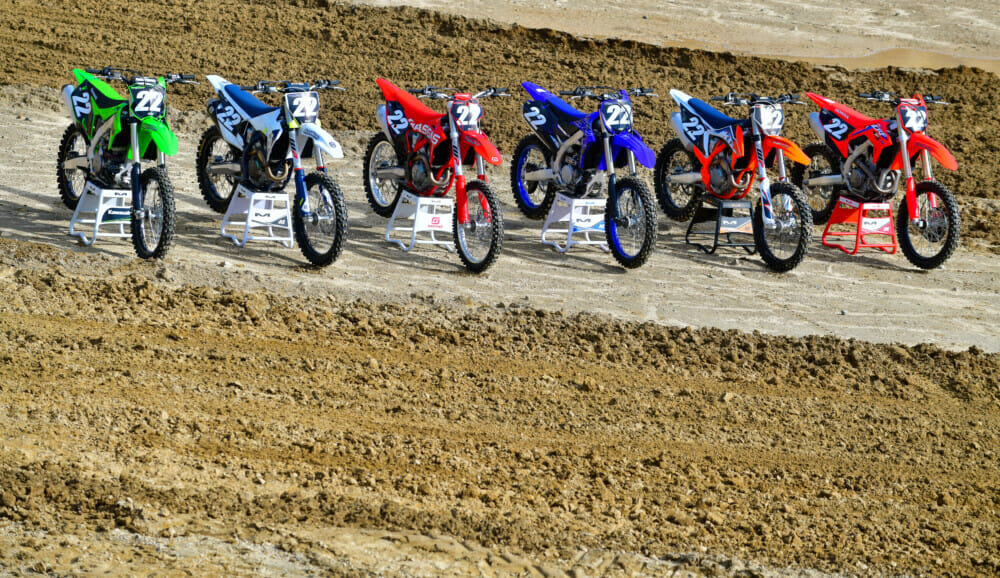
Sixth Place | Kawasaki KX250
The Kawasaki KX250 dropped a couple of notches from last year to sixth. But before we finish, let’s quiet one misconception—yes, it might have finished sixth out six but that doesn’t mean it’s a “last-place” bike. It’s an excellent motorcycle but just didn’t wow our testers as much as the others did.
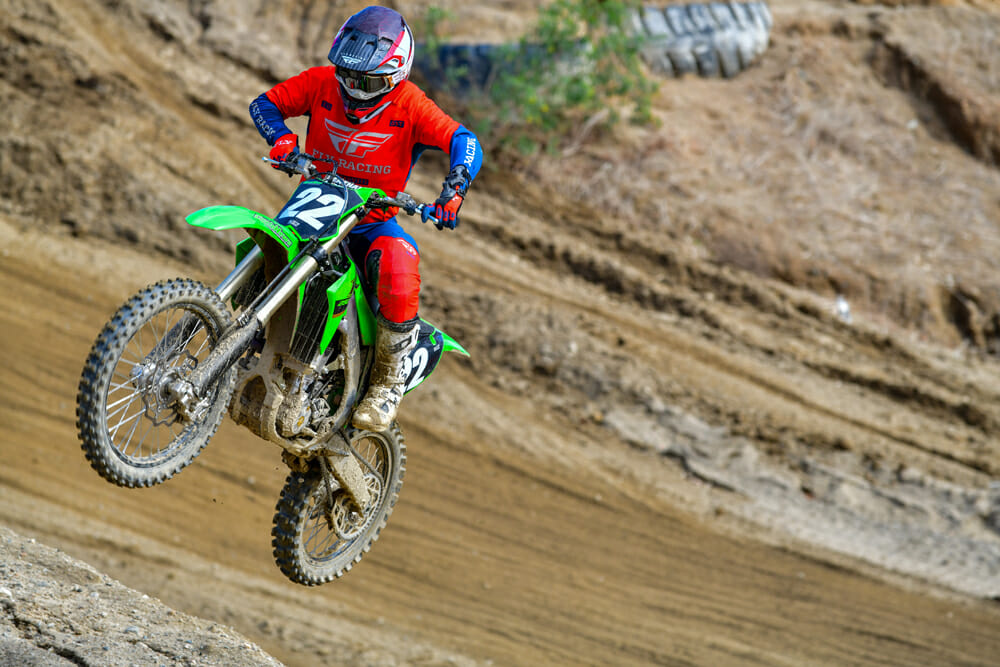 Sixth place? Really? Technically, the KX250 pulled up the rear on our list, but it’s not really a “last-place” bike. All it took were a few minor annoyances, like handlebars, grips, levers and a noisy chain guide, that prevented the Kawasaki from finishing higher up on our list. This just goes to show you how good all these bikes are on the track.
Sixth place? Really? Technically, the KX250 pulled up the rear on our list, but it’s not really a “last-place” bike. All it took were a few minor annoyances, like handlebars, grips, levers and a noisy chain guide, that prevented the Kawasaki from finishing higher up on our list. This just goes to show you how good all these bikes are on the track.
Let’s start with the good. This is the second year of this-generation KX. It’s a vast improvement from the former gen, equipped with a new frame, engine and body styling. Electric start and a hydraulic clutch are again highlighted this year. The KX also offers their Ergo-Fit system, which offers different mounting positions for the handlebars and footpegs. This can be a great feature for taller riders or those growing into the bike.
The KX250’s engine can run with the best of them. It’s another high-revving “hold onto your hats and glasses” kind of power that pulls from the get-go. A quick feather from the Nissin hydraulic clutch, and you’re off to the races. The engine in this generation emphasizes both top-end rev and bottom-to-mid pull. It has slightly shorter shift points than the KTM or Honda, but overall, it hits the mark and feels on par with the others as far as horsepower is concerned. As with the rest of the 250s, we preferred the Kawasaki in the most aggressive map or, in the KX’s case, coupler.
Interestingly enough, Kawasaki opts for two different suspension suppliers for their 250 and 450 KX models. The 250 rides on KYB components, the 450 Showa. We liked the settings on the KX250. Its stiff nature offered a solid, planted feel that could absorb big hits under power. The fork and shock are both super predictable and do everything as expected. This allowed us to stay on the gas longer down the hills at Glen Helen and hit jumps faster at Cahuilla. Our more experienced riders voiced their approval of the bike early in the days. On the flip side, later in the day, as the tracks became rougher, so did our experience on the KX. The rougher the track, the rougher it was to ride the KX, especially through choppy braking bumps.
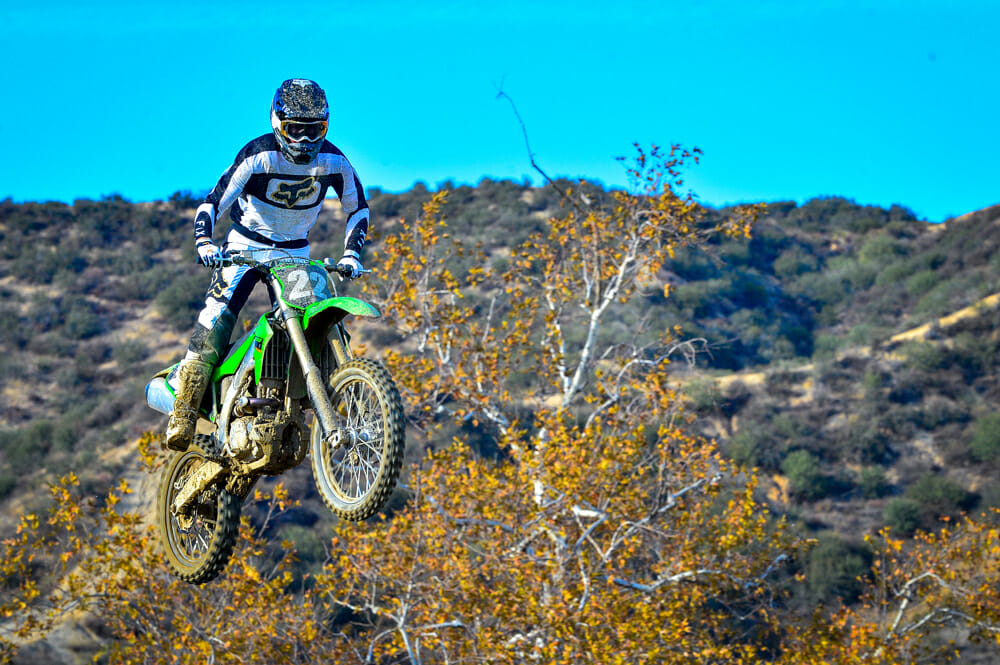 The KX250 still shines in the motor, chassis and handling departments. Suspension, however, needs attention when tracks get rough and choppy.
The KX250 still shines in the motor, chassis and handling departments. Suspension, however, needs attention when tracks get rough and choppy.
The Kawasaki does excel in many track conditions, just as long as those conditions are prepped. The KX is nimble in the tight sections, and it’s also stable in the wide-open ones. But as the track begins to break down, so does our confidence in the KX. The awful OEM grips, which are just too hard, and the awkwardly shaped skinny levers don’t do the rider any favors, either. The engine is noticeably loud, which, for some, is a nuisance. If you do not ride with earplugs, be sure to pick up a pair with your new KX.
As we said earlier, we don’t think the Kawi is a last-place bike. It does many things exceptionally well. But all it took were a few “annoyances” to hold the KX back.
Our testers noted that the Kawasaki would be a great project bike. We’d bet that 99 percent of those who buy this bike won’t leave it alone, at least not for very long. Replacing the Kawi’s bars, grips, levers, noisy chain guide—which you’d probably swap out anyway—will be first on their lists. We obviously can’t make these changes during our shootout days but we will go on record to say these mods will do a world of good for the Kawasaki.
Fifth Place | GasGas MC 250F
The GasGas MC 250F finds itself shuffled around in the running order for 2022. It finishes fifth in this year’s shootout despite being unchanged. The last of the Austrian machines is also the one with the lowest MSRP and subsequently offers the least amount of choice parts of the three.
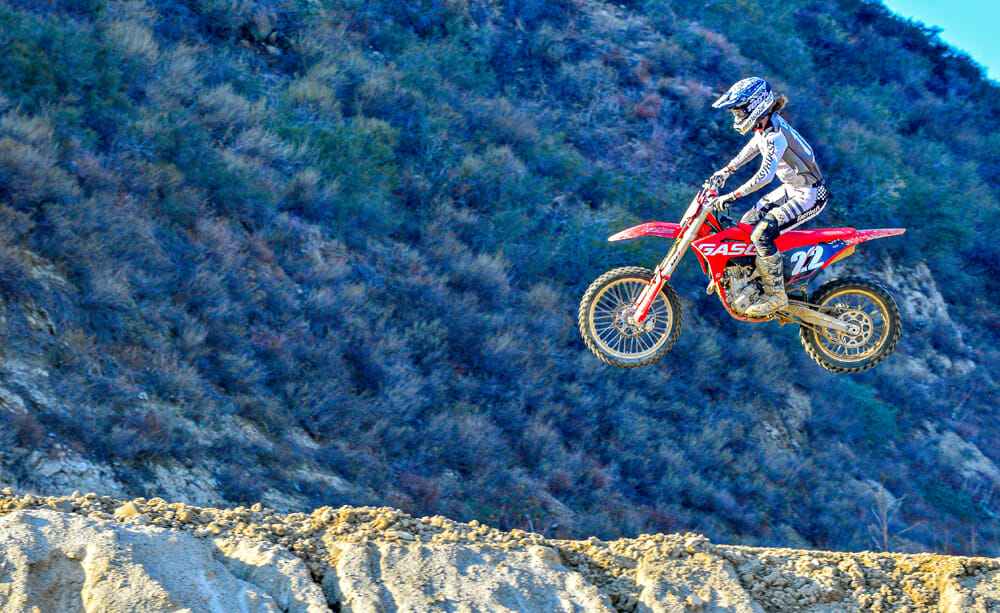 The GasGas is a fine motorcycle; it just lacks some of the premium hardware that some of the other bikes offer, most notably onboard mapping adjustability.
The GasGas is a fine motorcycle; it just lacks some of the premium hardware that some of the other bikes offer, most notably onboard mapping adjustability.
Now how can three nearly identical bikes receive such mixed reviews? Our GMC analogy from earlier shows that the GasGas is essentially a base model KTM—same engine, frame, swingarm and suspension (but the GasGas does have different suspension settings, and we’ll get to that). But the significant differences lie up front with the cast triple clamps, aluminum handlebars, and lack of mapping options. The Honda, Yamaha and Kawasaki all have cast triple clamps as well, but when comparing apples to apples to apples (KTM to Husqvarna to GasGas), one of these bikes ultimately gets moved to the lowest spot on the totem pole.
Eyes closed, the MC 250F feels darn similar to its Austrian relatives. The GasGas possess that smooth, revvy power that slices through long sections of the track. Its shift points are spread out, and the engine has plenty of over-rev up top. The lightweight feel of the Brembo clutch is another plus for the red rider. The only real difference in the engine department is the closed-off side panel that covers the airbox. The KTM and the Husqvarna offer a vented side panel that allows more airflow to the engine and, in turn, a more aggressive character. This is not an option (yet) on the GasGas, and therefore it maintains a smoother, more mellow power curve. Another main differentiator is the lack of a mapping switch. The GasGas is stuck in one map without the option for the more aggressive map two or traction control. Again, it is not a huge deal, but it does make a difference in the overall ranking.
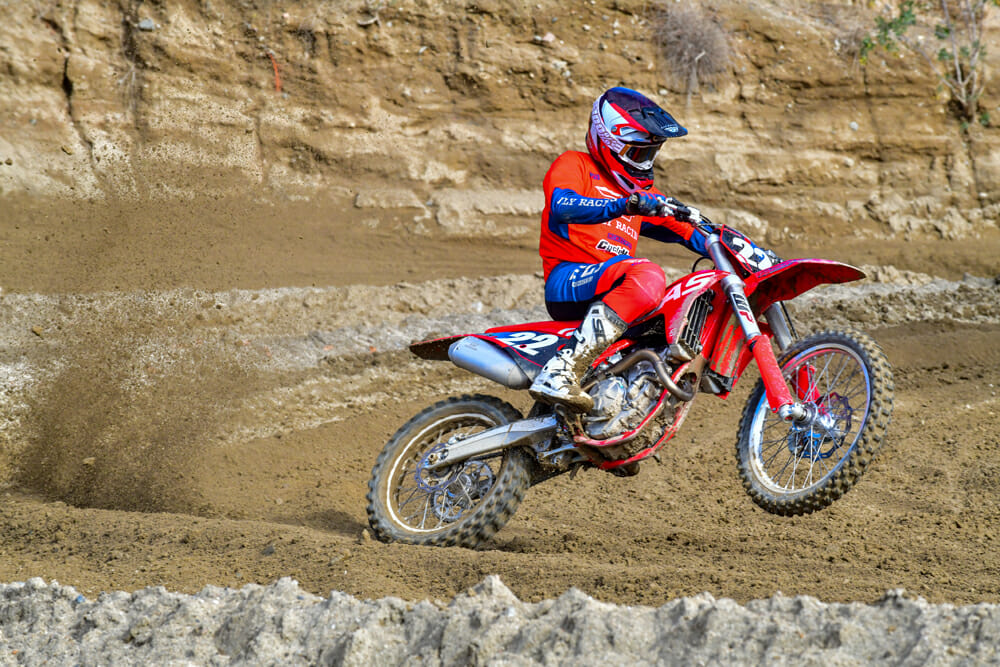 Of the six bikes tested, the GasGas is arguably the most user-friendly, especially in the power department.
Of the six bikes tested, the GasGas is arguably the most user-friendly, especially in the power department.
Where the GasGas lost out this year was simply due to its suspension. The bike felt way too soft even when we decreased sag or added air pressure to the fork. The softer nature of the WP settings made it feel much more playful and less aggressive. Our riders just couldn’t charge the track on the GasGas like they could on the other five bikes. Maintaining speed into jump faces and skipping through bumps or square edges felt more labor-intensive on this bike than any other. Last year, this bike was third on our list, but we believe that was because we enlisted an even blend of vet riders to pros. The vets favored this cushier setup and ultimately boosted the MC 250F up in the ranks. This year we had fewer vets and more intermediate to pro-level riders who preferred the stiffer, racier setups.
We picked the GasGas MC 250F for two applications. It serves as an excellent stepping stone for a rider graduating from a 125 to a 250. Its slightly mellower power and softer suspension are great for not as aggressive riders. On the other hand, it’s an excellent platform for riders who want to start on a budget but still want the same frame and engine components as a KTM or Husky. Saving $700 at the dealer gives you some extra money for suspension, exhaust and race entries.
Fourth Place | Husqvarna FC 250
Just missing out on a podium spot this year is the Husqvarna FC 250. The Husky continues to receive mixed reviews from testers and, in turn, continues to finish midpack during shootout season. It’s not for lack of trying, though. The Husqvarna sports some of the nicest OEM parts in the game but also has a price tag to match.
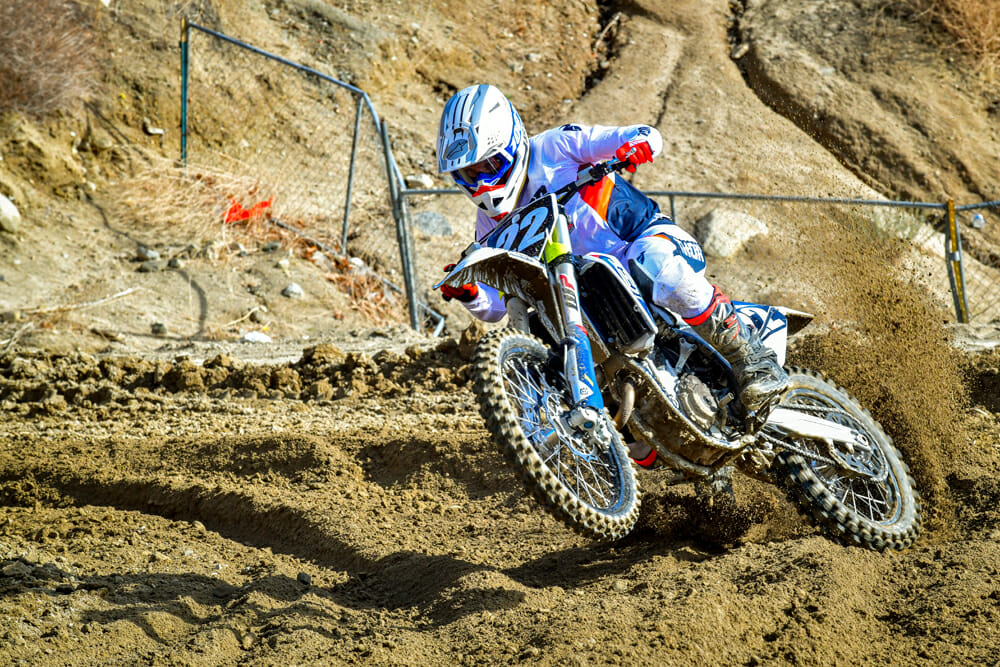 The Husqvarna simply rips, but it’s also the most expensive.
The Husqvarna simply rips, but it’s also the most expensive.
The biggest difference between the Husqvarna and the KTM is in the suspension. Yes, it does come equipped with the same WP Xact components as the KTM and the GasGas, but the Husky’s sticks and shock are 10mm shorter than the others. This makes the FC’s seat height about half an inch lower than the KTM (37.4 inches vs. 37.0 inches). This design aimed to centralize the mass of the bike, keep it slightly lower to the ground, and make it easier to turn. It’s a great idea on paper, but it receives mixed opinions each year—the shorter riders enjoy it, and the taller riders aren’t often as excited. If we had more shorter riders than taller ones in our stable of testers this year, perhaps our shootout results would have been different.
One place where the lowered Husky shines is in tight turns and flat corners. Its ability to lean over makes the FC feel like a crouched tiger, stalking the perfect line, ready to pounce and destroy any berm in sight. You can easily square up big bowl turns or dart from outside to inside with apparent ease. Where it falls short is braking bumps or rough chop under power. More specifically, bombing the downhills at Glen Helen. Our riders felt that they needed to stiffen the suspension to get more hold up and more confidence in these areas of the track.
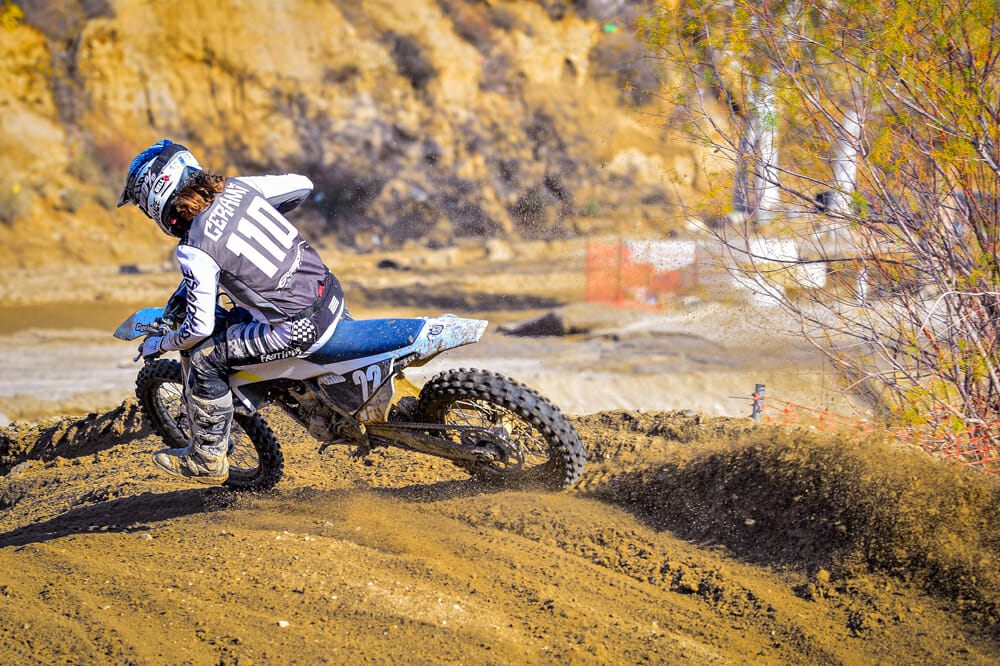 The Husky has a lower stance. Depending on your stature, that could be a good thing—or not.
The Husky has a lower stance. Depending on your stature, that could be a good thing—or not.
The Husqvarna’s engine was well-received, and rightly so. It’s the same engine from our second-place finisher (KTM). You’ll find few changes from one Austrian bike to the other in the engine department. The FC offers that long, linear pull through the range and has virtually no sign-off. A Brembo hydraulic clutch comes standard on the FC and provides effortless pull as you log laps. The vented airbox and OEM map switch are other premium features that we indulged in, opting for the more aggressive setting every time.
It’s hard enough to pick one winner in a field of practically unchanged motorcycles. Now try to decipher three bikes that are verging on identical triplets! The Husqvarna does have a few key differences from its fellow Austrians: carbon subframe, lower suspension, white body styling and ProTaper handlebars. However, the Husqvarna fell just a few points shy of podium territory in the overall ranking. Shorter riders or those who crave the most premium features will favor the FC 250.
Third Place | Honda CRF250R
The 2022 Honda CRF250R is the bike that everyone has been asking about. Our email inboxes and social media comments are full of questions asking what it’s like. It is the only 250 to be completely re-done for this model year, and it’s leaps and bounds better than what it was just a year ago. The Honda finds itself three spots up and on the podium for 2022, moving from sixth to third.
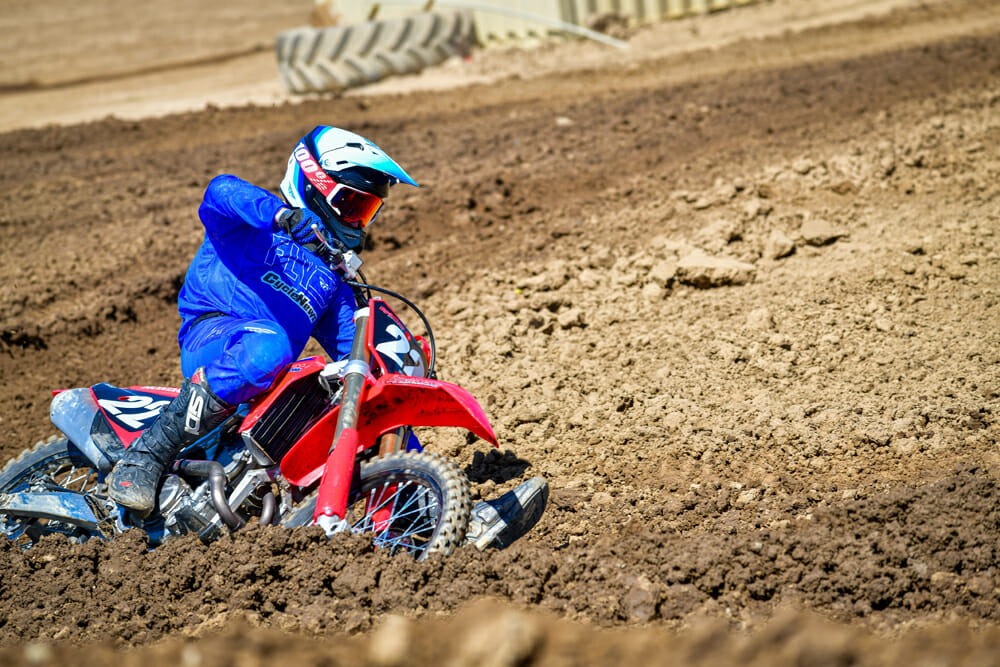 The Honda CRF250R is the most changed of ’22 and, as a result, moved up a few notches from last year’s shootout. It’s an all-around better motorcycle.
The Honda CRF250R is the most changed of ’22 and, as a result, moved up a few notches from last year’s shootout. It’s an all-around better motorcycle.
Granted, Jett Lawrence did win the Pro Motocross Championship on the 2021 Honda, which finished last in our shootout. That just goes to show that shootouts aren’t the end-all-be-all and that money, resources and more money can make any bike perfect for you. For our tests, though, we are riding the bikes in their true stock form, how they’d be when you buy one off the showroom floor.
Back to the new bike. We’re super happy with Honda’s updates to the 2022 CRF. It’s lighter, smoother and better in almost every way compared to last year’s model. This could be our favorite bike of the bunch on any given day. But riding these bikes back-to-back-to-back means you easily identify areas of improvement.
All of our test riders praised the CRF250R’s motor due to its friendly nature and overall rideability. Honda successfully reworked their engine to provide more crucial bottom-end power. It also has a much more linear pull from bottom to mid. The meat of the power is considerably more useful and has higher ranges than the ’21. Second and third gears are functional now! The former generation’s engine was like riding a pipey 125 two-stroke rather than a linear four-stroke. Now riders can enjoy a solid pull through the rpm range and a hearty over-rev of the red ride. We’ll take this engine any day.
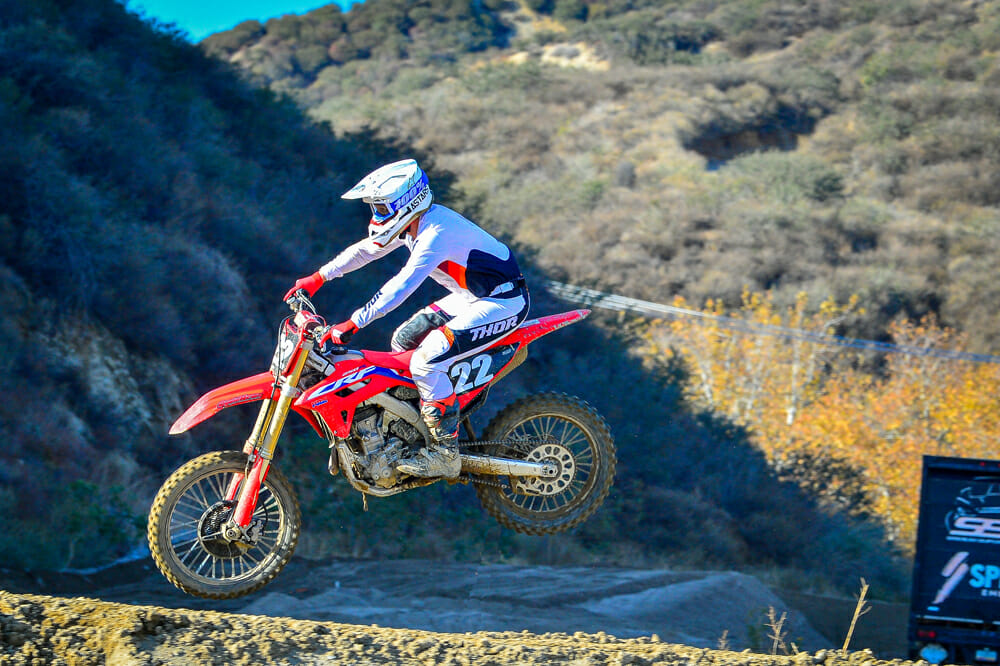 The Honda’s suspension is improved for ’22 but still needs some tweaking.
The Honda’s suspension is improved for ’22 but still needs some tweaking.
Honda’s new frame is also a significant change for the new year. The sharp lines, ultra-thin radiator shrouds and flat seat seem to take after the KTM. And did we mention the single exhaust is back? Thankfully. Ditching the two bulky mufflers again aids in that slim feeling on the CRF. This more neutral design looks to be the way of the future as Honda is the first Japanese brand implementing the “European” styling. Regardless, we’re a fan of this design, and every one of our riders commended the Honda’s narrow and rider-friendly cockpit.
The suspension is ultimately where the Honda fell short. The new chassis is stiff and precise, but the forks felt too soft, which also unweighted the rear end and made it feel too light and unpredictable. Our riders turned the compression in two clicks on the fork to stiffen it up and get more balance placed on the rear. These clicks improved the overall feeling of the bike’s handling, as it became much more settled and predictable under heavy braking.
Our riders applauded the new frame, rider cockpit and improvements to the engine. However, as the tracks roughened up late in the day, the ultra-stiff Honda simply became harder and harder to hang on to. This is the first rendition of the new CRF, and the red riders are certainly on the right track.
Second Place | KTM 250 SX-F
Not far behind our winning Yamaha—which you should have figured out by now—in second place is the 2022 KTM 250 SX-F. The KTM is the highest-ranking Austrian machine in the mix due to its lively personality and overall well-roundedness on the track. This is also the second year in a row the 250 SX-F has finished in the bridesmaid position. Once again, the KTM lives up to its “Ready To Race” mantra.
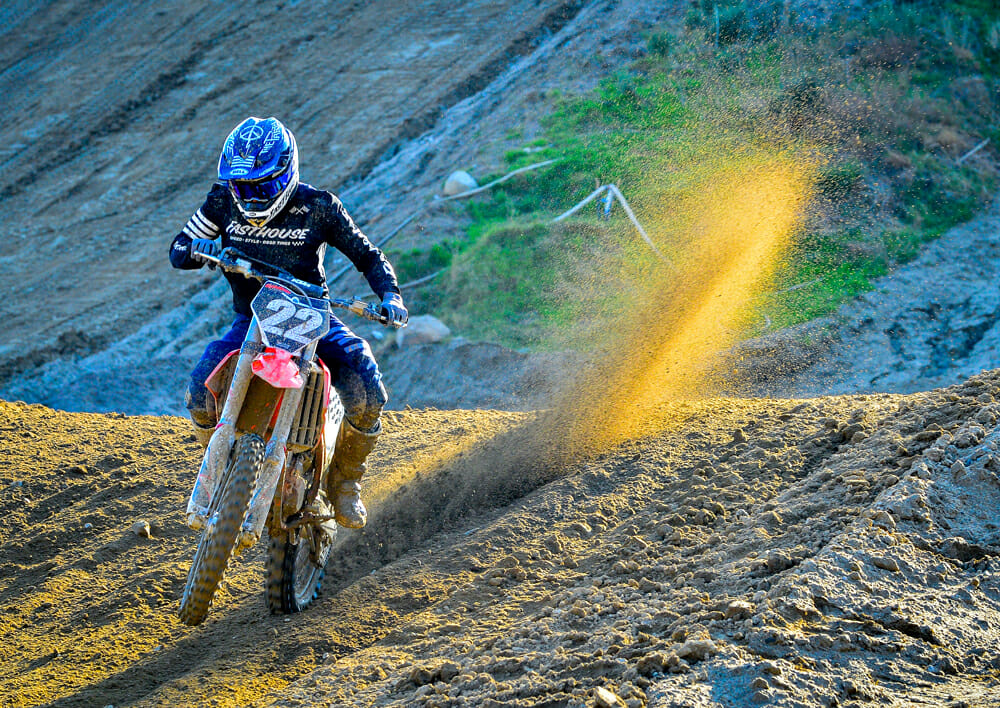 We had to split hairs in determining first and second places in this shootout. The difference between the KTM and the Yamaha basically boiled down to their forks—our testers still prefer the feel of the Yami’s SSS spring forks versus the KTM’s air forks.
We had to split hairs in determining first and second places in this shootout. The difference between the KTM and the Yamaha basically boiled down to their forks—our testers still prefer the feel of the Yami’s SSS spring forks versus the KTM’s air forks.
There are possibly no two bikes in the class that are as different from one another as the Yamaha and the KTM—spring fork versus air, wider shrouds of the Yamaha versus the narrow ones on the KTM, the Yamaha’s hard-hitting power versus the KTM’s linear character. The list goes on, and, interestingly, two totally contrasting machines finished 1-2 again.
The KTM is simply razor-thin in every way—from its slim bodywork to its agile chromoly frame. This bike excels in tight turns and flat corners. There’s just something about the machine’s flexibility that allows the rider to point and shoot with absolute precision. Our testers noted that they could make quick direction changes without sacrificing any of the comfortable “planted” feeling—the best of both worlds in a purpose-built racing machine. We tested at both Glen Helen and Cahuilla Creek. Both tracks feature wide-open layouts that favor a more stable bike. Despite being so agile, the KTM hung with the best of them but would’ve likely taken the cake on tighter tracks.
Power on the KTM is also notable and is perhaps the most usable in the class. Again, a stark contrast from the Yamaha, the KTM’s engine feels smoother and more refined. If the YZ is a hotrod, then the KTM is a Cadillac. Yes, both are fast and have roughly the same top speed, but the way they get you there is entirely different. The KTM’s linear powerband is super smooth in practically any rpm range, making the bike easy to ride. Second and third gears were again some of the most versatile in the class and felt like a godsend throughout the rolling elevation changes of Glen Helen and Cahuilla. The mid-to-top carry-through on the KTM is simply unmatched.
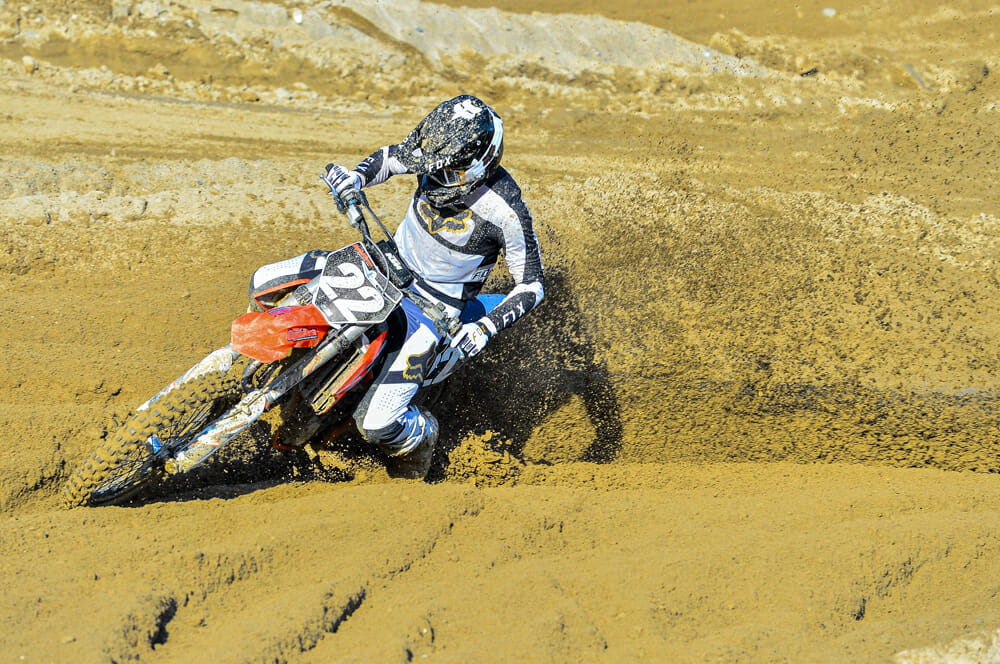 There are many things to like about the KTM, horsepower is one of them.
There are many things to like about the KTM, horsepower is one of them.
The KTM continues to rely on WP suspension components. The Xact air fork and Xact shock are still the best iterations we’ve felt to date. It has much more of a spring-like feel than the earlier versions and has a much plusher initial stroke, too. The front end feels light and compliments the compliance of the nimble steel chassis. This is also a key in how the KTM keeps weight off the scales. Without the matching spring-loaded fork tubes, the orange machine maintains a light 232 pounds, tied as the lightest in class. Our test riders loved the easy-to-use fork clickers that can be easily accessed from the side of the track, meaning fewer trips to the van to make simple adjustments. Just twist the plastic dial, and you’re back on track.
Okay, we know what you’re thinking: if it’s so good, then why didn’t it win? The KTM was unanimously picked as the best Austrian bike of the bunch but fell just short of the YZ in the overall rankings. While the KTM’s suspension is better than it’s ever been, most of our riders still preferred the feeling of the springs. The motor is undoubtedly strong but lacks the Yamaha’s extra excitement. Finally, the footpegs were a key talking point. The KTM’s ’pegs were simply a bit narrower in their overall platform shape. Yes, we’re nitpicking, but that’s what it takes these days.
This KTM’s 250 SX-F generation has consistently been a podium threat and takes home another second in our shootout.
First Place | Yamaha YZ250F
The blue bike stands atop the Cycle News podium, once again, in 2022. All our test riders, regardless of ability, unanimously ranked the YZ250F in first place. The Factory Star Racing Team undeniably solidified this bike as a winner at the pro level, but the best part is it’s a front runner even in stock trim.
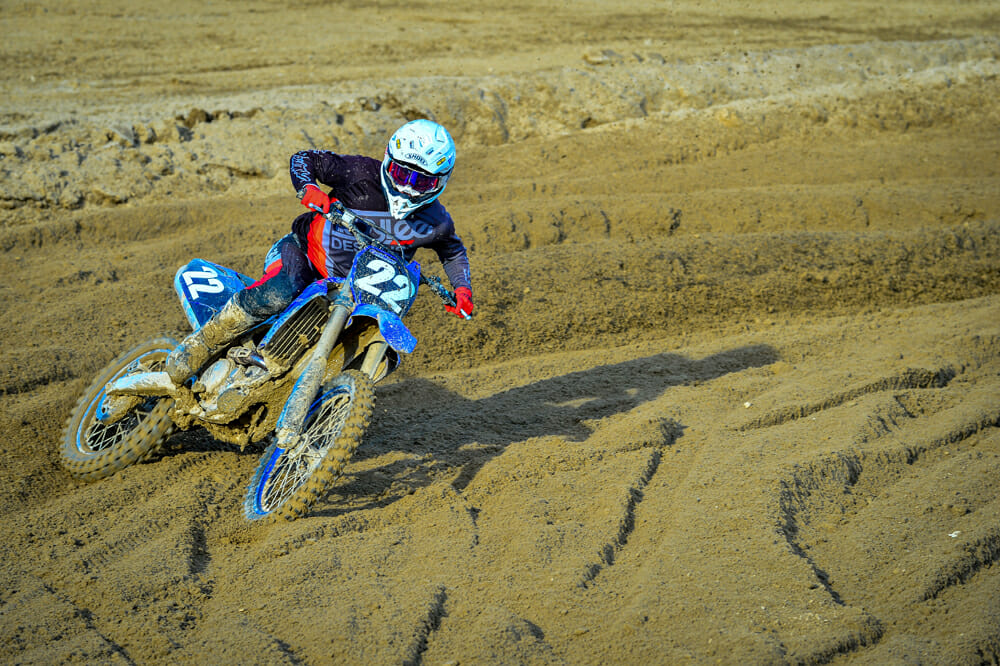 The Yamaha YZ250F was a unanimous winner among our test riders. There just isn’t anything the YZ doesn’t do well.
The Yamaha YZ250F was a unanimous winner among our test riders. There just isn’t anything the YZ doesn’t do well.
Simply put, the 2022 YZ250F is the easiest 250F to ride. The cockpit is noticeably comfortable from the get-go, and the peg, bar, seat ratios were easily adaptable for every rider. Footpegs were a highlight for all our riders. They praised the wide and solid platform of the stock units right away.
Speaking of wide, the YZ still feels wider at the knees when compared to the thin Austrian bikes or the new Honda. From a first look, the cockpit of the Yamaha is much “rounder” than the sharpness of the others. This contributes to that wider feeling, when in reality it’s only an inch or two difference. We didn’t overlook that width, but our testers adjusted accordingly and didn’t make further mention of it hindering the bike’s overall riding experience.
On to the motor. If you want fast and in-your-face power, the Yamaha again rises to the top. The snappy engine character is ultra-responsive nearly everywhere in the power curve. The bottom end has enough oomph to pull you out of a corner and quickly transitions to the meaty mid-to-top. This is where the bike excels. You can keep pouring on the revs as long as your eardrums can handle it. Yes, the Yamaha’s front-facing airbox and exhaust system are still obnoxiously loud, but the power just makes it so worth it. The Power Tuner App is another standard option on the YZ that sets it apart. You can fine-tune engine settings from the convenience of your smartphone. We enjoyed the aggressive “over-rev” map that Yamaha loaded onto our bike and used it for most of our two-day test.
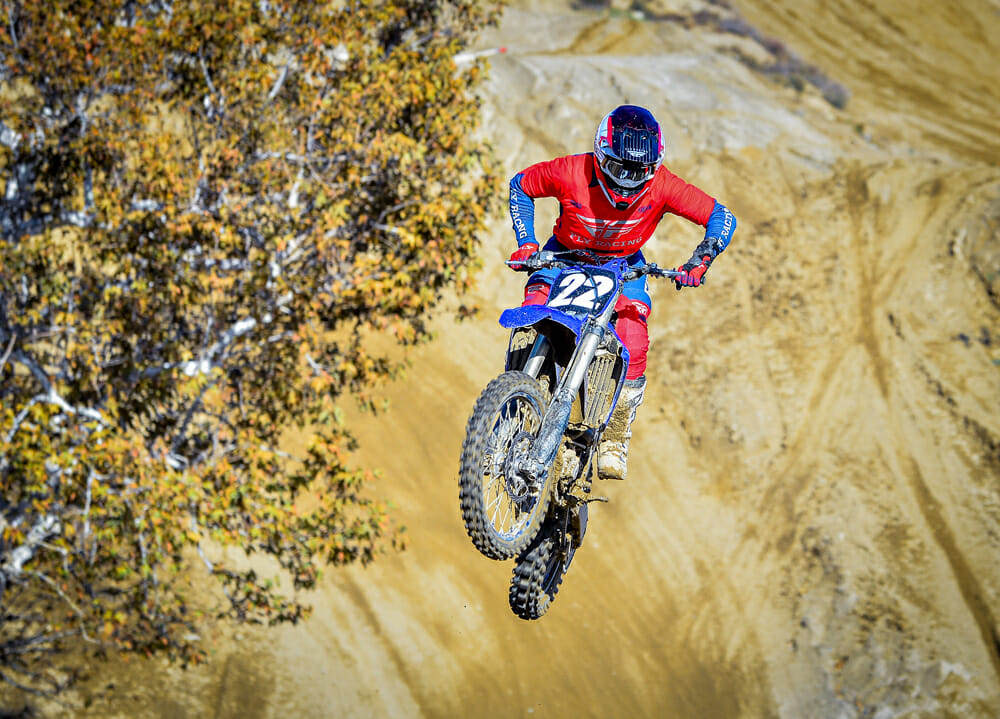 The Yamaha is a well-rounded package with a robust motor and plush suspension that are matched to a solid chassis. And it also has the best engine tuner of the group.
The Yamaha is a well-rounded package with a robust motor and plush suspension that are matched to a solid chassis. And it also has the best engine tuner of the group.
But wait, there’s more. The suspension on the YZ250F is the icing on the cake. For the past few years, the KYB components on the blue bike have been simply top-notch right out of the box. Four of our six riders were comfortable without needing to touch the clickers, and the other two only made minor, one- or two-click adjustments to find their sweet spot. You can go fast, charge through rough sections, and go deep on landings with little to no consequences. We did notice, though, how much the bike moves around. And don’t take this the wrong way. With suspension like this, the bike practically does all the work for you. It may not be the lightest bike in the class, but you’d never know it. You direct it where to go, it stays planted, and you twist that freakin’ grip. The butter-smooth function of the suspension eats up chop for breakfast and allows the rest of the bike to dance harmoniously underneath the rider. As we said, the bike is just plain easy to ride.
The Yamaha YZ250F graces the top step of the Cycle News podium once again. Due to its fast yet rideable power, class-leading suspension and technological advancements, it edged away from the competition. All six of our testers ranked it first, making it the clear-cut winner in the class of 2022.
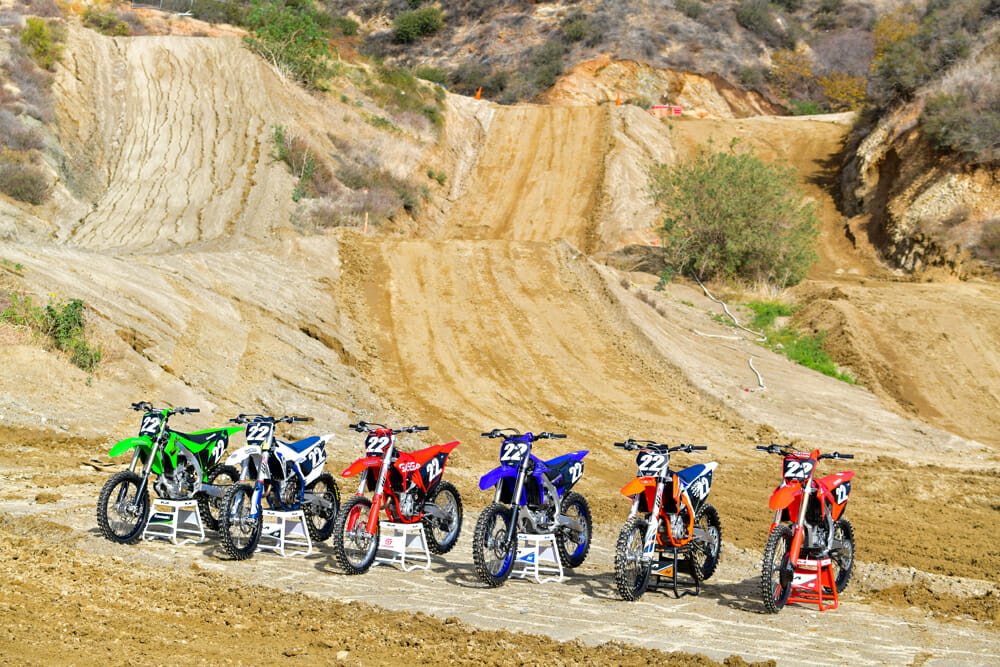
2022 250cc Four-Stroke Motocross Shootout Wrap-Up
This year’s shootout was one of the most difficult in recent memory. Without any real changes happening to five of the six bikes, our team split hairs to determine an overall ranking. The Honda CRF250R was the only bike that received significant updates, and while they weren’t enough to take the win, the Red Riders showed they are certainly on the right track—moving from sixth to third in just one year.
The KTM 250 SX-F again reaffirmed its position as the best Austrian bike, while the Yamaha YZ250F took a unanimous victory amongst our test riders.
The other bikes on the grid are downright impressive too. Every machine finds its niche where it can shine. But as always, only one can stand atop the podium. We’re confident you’ll be pleased with any of these machines, but we feel you’ll be most pleased with the Yamaha.CN
